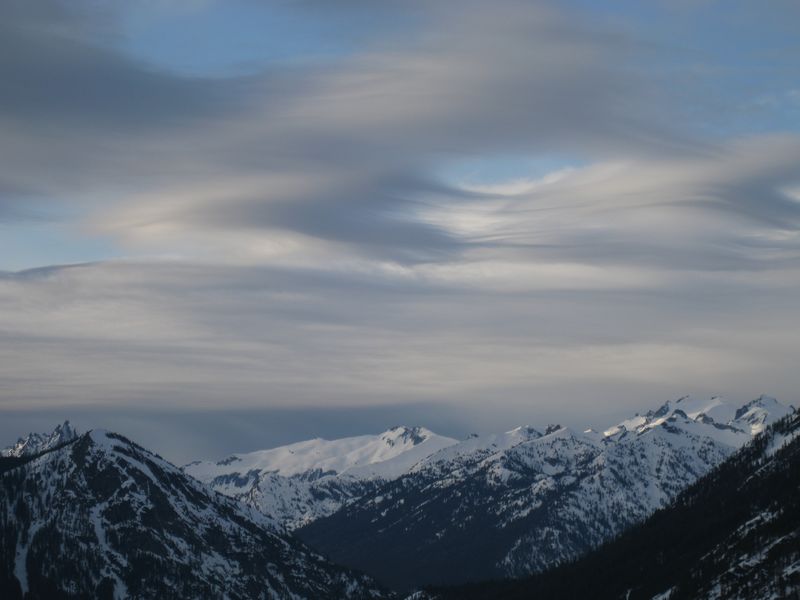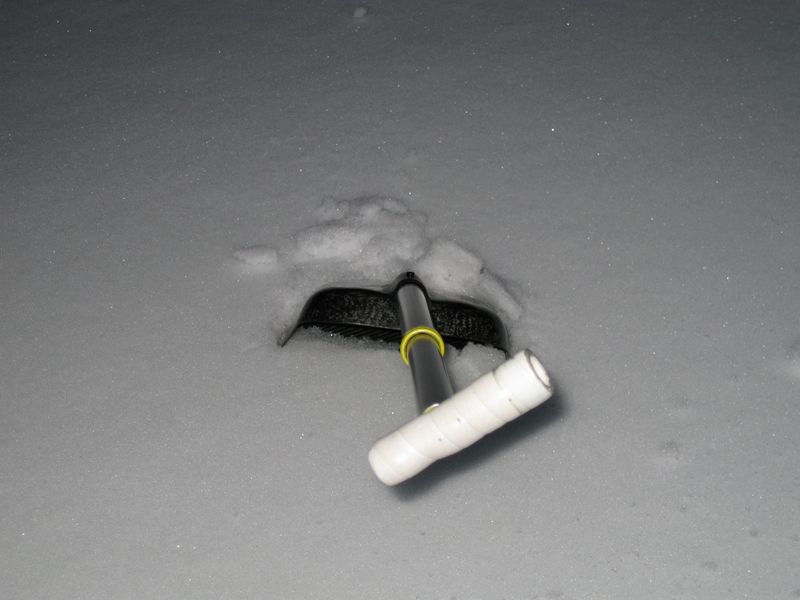March 12-13, 2008, Sasse Ridge
3/12/08
2449
1
This was another nice week at Sasse Ridge, making 4 weeks in a row with excellent top to bottom skiing, in part because I have lucked out on the weather. The snowpack has just begun to shrink on the valley floor (2300 feet), but there is still about 3 feet left. At 3800 feet, the top one foot of snow is staying reasonably consolidated all day, but under that surface layer is large grained unbounded snow (rotten snow). At night a good freeze takes place, but soon that upper foot will turn into rotten snow in the afternoon too. So it's getting near the time when it's best to travel early. The good thing about the rotten snow season, at least until the snow starts sintering, is that it's not suitable for snomos. Higher up the snowpack is still in winter mode.
There has not been much unusual to photograph recently, however the view of Daniel and Hinman Wednesday evening was quite interesting. Particularly the layered clouds which looked like a giant ski slope. See the first pic. At least for my own amusement, I'll see if I can explain how this cloud structure comes about. I hope one of the members of the TAY Dept. of Atmospheric Sciences will correct any errors - - or perhaps note that the following is just plain wrong. :)
The basic idea is that when there is relative movement between two fluid layers, waves are generated and the wave crests are perpendicular to the direction of flow at the interface. (Air flowing over water is a familiar example. For the purposes of considering wind flow, air can be considered a fluid.) All you need is differential flow; the air can move over the water, or the water can move under still air, or any combination.
When layers in the atmosphere do not mix significantly, they too act like different fluid layers. Waves are created at the interface of the two layers, again perpendicular to the relative flow. (Remember, each layer may be moving in a different direction with respect to a viewer on the surface, so the orientation and general movement of the waves is a somewhat hard to visualize combination of both flow directions.)
If the air in the lower layer is near the point at which water vapor will condense, when a wave displaces some of this lower layer air upwards, it may condense, and when the wave displaces the air downwards again, the condensation (cloud) will dissipate. This produces the banded cloud pattern high in the atmosphere that often precedes incoming moisture. It's more unusual to see this banding lower down, and even more unusual to see it lit from underneath by the setting sun, as in the photo. I think the picture also shows that the interface between the two layers generating the waves does not have to be exactly in plane with the earth's surface. Watching these fascinating clouds, it appeared that the wave producing interface was tipped rather like a huge ski slope, with the waves being various ribs and gullies.
Now a mention of something I know more about. Have you ever bruised the inside of your thumb joint using a tee handled snow shovel? This is easy to do shoveling out campsites when the snow is hard. The tee handle puts a lot of force on the ligament at the base of your thumb opposite your index finger (the ulnar collateral ligament). This is not a good ligament for a skier to damage, as it's the guilty party in 'skier's thumb', aka gamekeeper's thumb. It's a very common skiing injury, caused by hyper-abducting the thumb during a fall. Sometimes even a hunk of bone will be pulled off too at one of the attachment points of the ligament.
You might hazard a guess about why I would not like the tee handle, with the tee at 90 degrees to the handle. Here's my solution, one that I've used for 4 or 5 years now. See the pic. The tee is not set on the handle at 90 degrees, but more like a pistol grip. It's much more comfortable. In addition, the area that underlies the base of the thumb is hollowed out so it does not impinge on the area. Tee handles are usually set in the same plane as the blade, but for snow camping this is decidedly uncomfortable. Notice that the tee handle in the pic is twisted to about a 45 degree angle with respect to the blade. This combination has been far more comfortable for me, and has saved my thumb from being chronically sore. It also helps with 'skier's elbow' (lateral epicondylitis).
I should mention a bit about the shovel I guess. It's for ski camping; it's not an avy shovel. The blade was made for me by Graham Bantock of Sails Etc. in England using extra high modulus carbon fiber pre-preg, vacuum bagged and heat cured. It was a one off prototype weighing 7 ounces, but the production costs would have been prohibitive. I think it has perhaps 200 dollars of high modulus carbon in it! There is carbon fiber and then there is carbon fiber by the way. The expensive stuff is fantastically strong, or should I say, has an extremely high modulus of elasticity. The collapsible handle is shop made from fairly thin wall aluminum tubing.
Oh, sorry, this is supposed to be a trip report. Unread the last bits. :D
Larry
There has not been much unusual to photograph recently, however the view of Daniel and Hinman Wednesday evening was quite interesting. Particularly the layered clouds which looked like a giant ski slope. See the first pic. At least for my own amusement, I'll see if I can explain how this cloud structure comes about. I hope one of the members of the TAY Dept. of Atmospheric Sciences will correct any errors - - or perhaps note that the following is just plain wrong. :)
The basic idea is that when there is relative movement between two fluid layers, waves are generated and the wave crests are perpendicular to the direction of flow at the interface. (Air flowing over water is a familiar example. For the purposes of considering wind flow, air can be considered a fluid.) All you need is differential flow; the air can move over the water, or the water can move under still air, or any combination.
When layers in the atmosphere do not mix significantly, they too act like different fluid layers. Waves are created at the interface of the two layers, again perpendicular to the relative flow. (Remember, each layer may be moving in a different direction with respect to a viewer on the surface, so the orientation and general movement of the waves is a somewhat hard to visualize combination of both flow directions.)
If the air in the lower layer is near the point at which water vapor will condense, when a wave displaces some of this lower layer air upwards, it may condense, and when the wave displaces the air downwards again, the condensation (cloud) will dissipate. This produces the banded cloud pattern high in the atmosphere that often precedes incoming moisture. It's more unusual to see this banding lower down, and even more unusual to see it lit from underneath by the setting sun, as in the photo. I think the picture also shows that the interface between the two layers generating the waves does not have to be exactly in plane with the earth's surface. Watching these fascinating clouds, it appeared that the wave producing interface was tipped rather like a huge ski slope, with the waves being various ribs and gullies.
Now a mention of something I know more about. Have you ever bruised the inside of your thumb joint using a tee handled snow shovel? This is easy to do shoveling out campsites when the snow is hard. The tee handle puts a lot of force on the ligament at the base of your thumb opposite your index finger (the ulnar collateral ligament). This is not a good ligament for a skier to damage, as it's the guilty party in 'skier's thumb', aka gamekeeper's thumb. It's a very common skiing injury, caused by hyper-abducting the thumb during a fall. Sometimes even a hunk of bone will be pulled off too at one of the attachment points of the ligament.
You might hazard a guess about why I would not like the tee handle, with the tee at 90 degrees to the handle. Here's my solution, one that I've used for 4 or 5 years now. See the pic. The tee is not set on the handle at 90 degrees, but more like a pistol grip. It's much more comfortable. In addition, the area that underlies the base of the thumb is hollowed out so it does not impinge on the area. Tee handles are usually set in the same plane as the blade, but for snow camping this is decidedly uncomfortable. Notice that the tee handle in the pic is twisted to about a 45 degree angle with respect to the blade. This combination has been far more comfortable for me, and has saved my thumb from being chronically sore. It also helps with 'skier's elbow' (lateral epicondylitis).
I should mention a bit about the shovel I guess. It's for ski camping; it's not an avy shovel. The blade was made for me by Graham Bantock of Sails Etc. in England using extra high modulus carbon fiber pre-preg, vacuum bagged and heat cured. It was a one off prototype weighing 7 ounces, but the production costs would have been prohibitive. I think it has perhaps 200 dollars of high modulus carbon in it! There is carbon fiber and then there is carbon fiber by the way. The expensive stuff is fantastically strong, or should I say, has an extremely high modulus of elasticity. The collapsible handle is shop made from fairly thin wall aluminum tubing.
Oh, sorry, this is supposed to be a trip report. Unread the last bits. :D
Larry


Hey, I always say, "This site is useless without pictures of high carbon lightweight astronomical shovels." I like the snow crystals in the photo.
Reply to this TR
Please login first:
